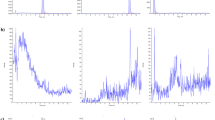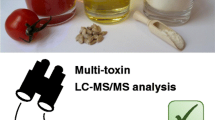Abstract
A HPLC-MS/MS-based method for the quantification of nine mycotoxins produced by fungi of the genus Alternaria in various food matrices was developed. The method relies on a single-step extraction, followed by dilution of the raw extract and direct analysis. In combination with an analysis time per sample of 12 min, the sample preparation is cost-effective and easy to handle. The method covers alternariol (AOH), alternariol monomethyl ether (AME), tenuazonic acid (TeA), altenuene (ALT), iso-altenuene (isoALT), tentoxin (TEN), altertoxin-I (ATX-I), and the AAL toxins TA1 and TA2. Some Alternaria toxins which are either not commercially available or very expensive, namely AOH, AME, ALT, isoALT, and ATX-I, were isolated as reference compounds from fungal cultures. The method was extensively validated for tomato products, bakery products, sunflower seeds, fruit juices, and vegetable oils. AOH, AME, TeA, and TEN were found in quantifiable amounts and 92.1 % of all analyzed samples (n = 96) showed low level contamination with one or more Alternaria toxins. Based on the obtained results, the average daily exposure to Alternaria toxins in Germany was calculated.



Similar content being viewed by others
References
Abbas HK, Tanaka T, Duke SO, Porter JK, Wray EM, Hodges L, Sessions AE, Wang E, Merrill AH, Riley RT Jr (1994) Fumonisin- and AAL-toxin-induced disruption of sphingolipid metabolism with accumulation of free sphingoid bases. Plant Physiol 106:1085–1093
Abbas HK, Vesonder RF, Boyette CD, Peterson SW (1993) Phytotoxicity of AAL-toxin and other compounds produced by Alternaria alternata to Jimsonweed (Datura stramonium). Can J Bot 71:155–160
Ackermann Y, Curtui V, Dietrich R, Gross M, Latif H, Märtlbauer E, Usleber E (2011) Widespread occurrence of low levels of alternariol in apple and tomato products, as determined by comparative immunochemical assessment using monoclonal and polyclonal antibodies. J Agric Food Chem 59:6360–6368
Akimitsu K, Peever TL, Timmer LW (2003) Molecular, ecological and evolutionary approaches to understanding Alternaria diseases of citrus. Mol Plant Pathol 4:435–446
An Y, Zhao T, Miao J, Liu G-T, Zheng Y-Z, Xu Y, van Etten L (1989) Isolation, identification, and mutagenicity of alternariol monomethyl ether. J Agric Food Chem 37:1341–1343
Asam S, Konitzer K, Schieberle P, Rychlik M (2009) Stable isotope dilution assays of alternariol and alternariol monomethyl ether in beverages. J Agric Food Chem 57:5152–5160
Brugger E, Wagner J, Schumacher DM, Koch K, Podlech J, Metzler M, Lehmann L (2006) Mutagenicity of the mycotoxin alternariol in cultured mammalian cells. Toxicol Lett 164:221–230
Carson ML (1985) Epidemiology and yield losses associated with Alternaria blight of sunflower. Phytopathology 75:1151–1156
D´Mello JPF, Placinta CM, Macdonald AMC (1999) Fusarium mycotoxins: a review of global implications for animal health, welfare and productivity. Anim Feed Sci Tech 80:183–205
Delgado T, Gómez-Cordovés C (1998) Natural occurrence of alternariol and alternariol methyl ether in Spanish apple juice concentrates. J Chromatogr A 815:93–97
European Committee for Standardization (CEN) Food Analysis - performance criteria for single laboratory validated methods of analysis for the determination of mycotoxins (CEN/TR 16059:2010). Austrian Standards Institute, Vienna, 2011
European Food Safety Authority (EFSA) (2008) EFSA comprehensive food consumption database. http://www.efsa.europa.eu/en/datexfoodcdb/datexfooddb. Accessed 2 September 2015
European Food Safety Authority (EFSA) (2011a) Scientific opinion on the risks for animal and public health related to the presence of Alternaria toxins in feed and food. EFSA J 9:1–97
European Food Safety Authority (EFSA) (2011b) Use of the EFSA Comprehensive European Food Consumption Database in Exposure Assessment. EFSA J 9:1–34
Fleck SC, Burkhardt B, Pfeiffer E, Metzler M (2012) Alternaria toxins: Altertoxin II is a much stronger mutagen and DNA strand breaking mycotoxin than alternariol and its methyl ether in cultured mammalian cells. Toxicol Lett 214:27–32
Gravesen S, Nielsen PA, Iversen R, Nielsen KF (1999) Microfungal contamination of damp buildings–examples of risk constructions and risk materials. Environ Health Perspect 107:505–508
Hasan HAH (1995) Alternaria mycotoxins in black rot lesion of tomato fruit: conditions and regulation of their production. Mycopathologia 130:171–177
Hickert S, Gerding J, Ncube E, Hübner F, Flett B, Cramer B, Humpf H-U (2015) A new approach using micro HPLC-MS/MS for multi-mycotoxin analysis in maize samples. Mycotox Res 31:109–115
Köhler W, Schachtel GA, Voleske P (2007) Biostatistik, 4, aktualisierte und erw Aufl. Springer-Lehrbuch. Springer, Berlin, Heidelberg, New York
Kosiak B, Torp M, Skjerve E, Andersen B (2004) Alternaria and Fusarium in Norwegian grains of reduced quality–a matched pair sample study. Int J Food Microbiol 93:51–62
Králová J, Hajslová J, Poustka J, Hochmann M, Bjelková M, Odstrcilová L (2006) Occurrence of Alternaria toxins in fibre flax, linseed, and peas grown in organic and conventional farms: monitoring pilot study. Czech J Food Sci 24:288–296
Kroes R, Renwick A, Cheeseman M, Kleiner J, Mangelsdorf I, Piersma A, Schilter B, Schlatter J, van Schothorst F, Vos J, Würtzen G (2004) Structure-based thresholds of toxicological concern (TTC): guidance for application to substances present at low levels in the diet. Food Chem Toxicol 42:65–83
Lau BP, Scott PM, Lewis DA, Kanhere SR, Cléroux C, Roscoe VA (2003) Liquid chromatography–mass spectrometry and liquid chromatography–tandem mass spectrometry of the Alternaria mycotoxins alternariol and alternariol monomethyl ether in fruit juices and beverages. J Chromatogr A 998:119–131
Liu Y, Rychlik M (2013) Development of a stable isotope dilution LC-MS/MS method for the Alternaria toxins tentoxin, dihydrotentoxin, and isotentoxin. J Agric Food Chem 61:2970–2978
Liu Y, Rychlik M (2015) Biosynthesis of seven carbon-13 labeled Alternaria toxins including altertoxins, alternariol, and alternariol methyl ether, and their application to a multiple stable isotope dilution assay. Anal Bioanal Chem 407:1357–1369
Loggrieco A, Moretti A, Solfrizzo M (2009) Alternaria toxins and plant diseases: an overview of origin, occurrence and risks. World Mycotoxin J 2:129–140
Lohrey L, Marschik S, Cramer B, Humpf H-U (2013) Large-scale synthesis of isotopically labeled 13C2 -tenuazonic acid and development of a rapid HPLC-MS/MS method for the analysis of tenuazonic acid in tomato and pepper products. J Agric Food Chem 61:114–120
Malachová A, Sulyok M, Beltrán E, Berthiller F, Krska R (2014) Optimization and validation of a quantitative liquid chromatography-tandem mass spectrometric method covering 295 bacterial and fungal metabolites including all regulated mycotoxins in four model food matrices. J Chromatogr A 1362:145–156
Noser J, Schneider P, Rother M, Schmutz H (2011) Determination of six Alternaria toxins with UPLC-MS/MS and their occurrence in tomatoes and tomato products from the Swiss market. Mycotox Res 27:265–271
Ostry V (2008) Alternaria Mycotoxins: an overview of chemical characterization, producers, toxicity, analysis and occurrence in foodstuffs. World Mycotoxin J 1:175–188
Pero RW, Owens RG, Dale SW, Harvan D (1971) Isolation and identification of a new toxin, altenuene, from the fungus Alternaria tenuis. Biochimi Biophys Acta 230:170–179
Pero RW, Posner H, Blois M, Harvan D, Spalding JW (1973) Toxicity of metabolites produced by the "Alternaria". Environ Health Perspect 4:87–94
Pfeiffer E, Eschenbach S, Metzler M (2007) Alternaria toxins: DNA strand-breaking activity in mammalian cells in vitro. Mycotox Res 23:152–157
Prelle A, Spadaro D, Garibaldi A, Gullino ML (2013) A new method for detection of five Alternaria toxins in food matrices based on LC-APCI-MS. Food Chem 140:161–167
Rang J, Crous PW, Mchau GRA, Serdani M, Song S (2002) Phylogenetic analysis of Alternaria spp. associated with apple core rot and citrus black rot in South Africa. Mycol Res 106:1151–1162
Scott PM, Lawrence GA, Lau BP (2006) Analysis of wines, grape juices and cranberry juices for Alternaria toxins. Mycotox Res 22:142–147
Stack ME, Mazzola EP, Page SW, Pohland AE (1986) Mutagenic perylenequinone metabolites of Alternaria alternata: altertoxins I, II and III. J Nat Prod 49:866–871
Stickings CE (1959) Metabolites of Alternaria tenuis auct.: the structure of tenuazonic acid. Biochem J 72:332–340
Stockmann-Juvala H, Savolainen K (2008) A review of the toxic effects and mechanisms of action of fumonisin B1. Hum Exp Toxicol 27:799–809
Streit E, Schwab C, Sulyok M, Naehrer K, Krska R, Schatzmayr G (2013) Multi-mycotoxin screening reveals the occurrence of 139 different secondary metabolites in feed and feed ingredients. Toxins (Basel) 5:504–523
Sulyok M, Krska R, Schuhmacher R (2007) A liquid chromatography/tandem mass spectrometric multi-mycotoxin method for the quantification of 87 analytes and its application to semi-quantitative screening of moldy food samples. Anal Bioanal Chem 389:1505–1523
Sulyok M, Krska R, Schuhmacher R (2010) Application of an LC–MS/MS based multi-mycotoxin method for the semi-quantitative determination of mycotoxins occurring in different types of food infected by moulds. Food Chem 119:408–416
van der Waals JE, Korsten L, Slippers B (2004) Genetic diversity among Alternaria solani isolates from potatoes in South Africa. Plant Dis 88:959–964
Walravens J, Mikula H, Rychlik M, Asam S, Ediage EN, Mavungu D, Diana J, van Landschoot A, Vanhaecke L, de Saeger S (2014) Development and validation of an ultra-high-performance liquid chromatography tandem mass spectrometric method for the simultaneous determination of free and conjugated Alternaria toxins in cereal-based foodstuffs. J Chromatogr A 1372:91–101
Yang D (2005) Isolation of wood-inhabiting fungi from Canadian hardwood logs. Can J Microbiol 51:1–6
Zhao K, Shao B, Yang D, Li F (2015) Natural occurrence of four Alternaria mycotoxins in tomato- and citrus-based foods in China. J Agric Food Chem 63:343–348
Acknowledgments
The authors thank Sciex (Darmstadt) for supply of a QTRAP® 5500 mass spectrometer. We thank Angela Klusmeier-König and Imke Westkamp for support during sample preparation.
Source of funding
We thank the NRW Graduate School of Chemistry for the financial support.
Conflicts of interest
None.
Author information
Authors and Affiliations
Corresponding author
Electronic supplementary material
Detailed description of the isolation procedure for AOH, AME, ALT, isoALT and ATX-I from fungal cultures including spectroscopic data and NMR data of synthesized TeA can be found in the Supplementary Material. Table S1 gives the complete validation parameters for all matrices, Tables S2 and S3 give concentrations of all calibration levels and spiking levels for method performance assessment.
ESM 1
(DOCX 88 kb)
Rights and permissions
About this article
Cite this article
Hickert, S., Bergmann, M., Ersen, S. et al. Survey of Alternaria toxin contamination in food from the German market, using a rapid HPLC-MS/MS approach. Mycotoxin Res 32, 7–18 (2016). https://doi.org/10.1007/s12550-015-0233-7
Received:
Revised:
Accepted:
Published:
Issue Date:
DOI: https://doi.org/10.1007/s12550-015-0233-7




